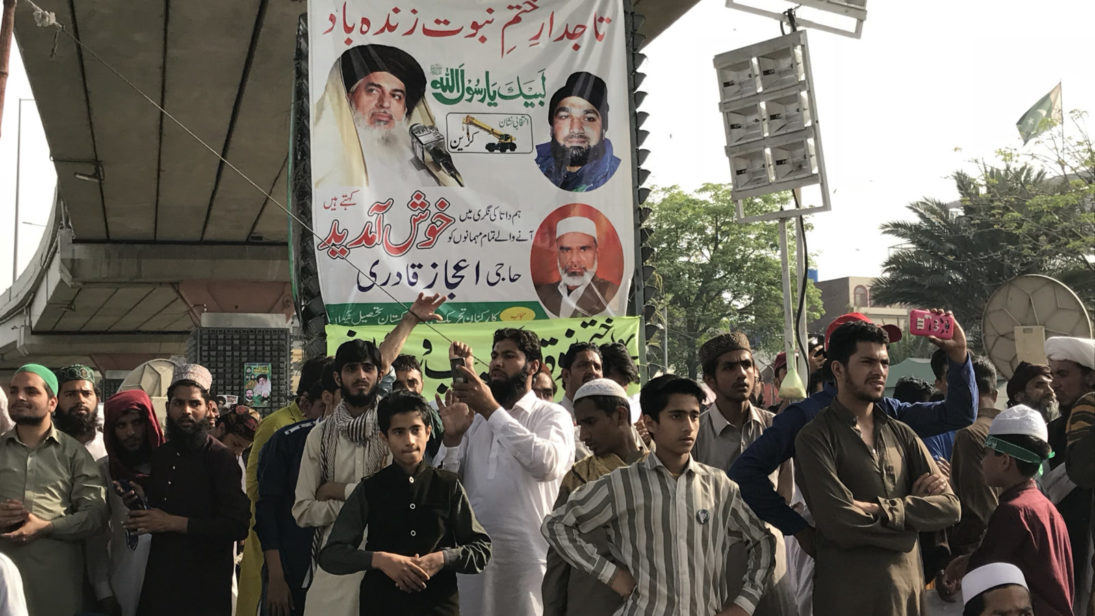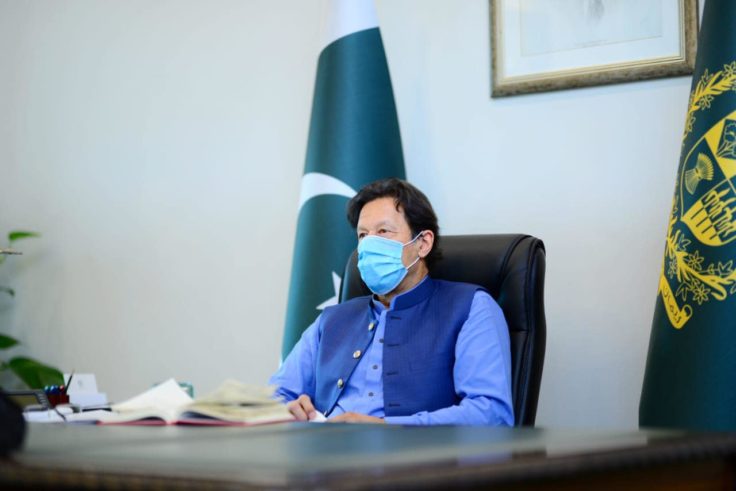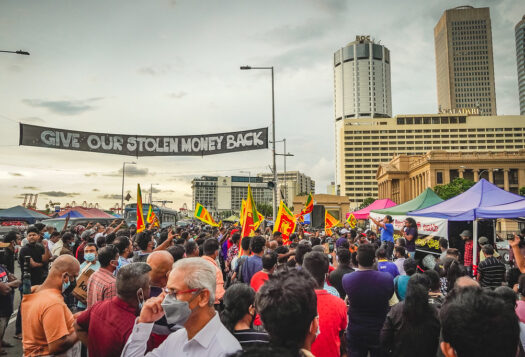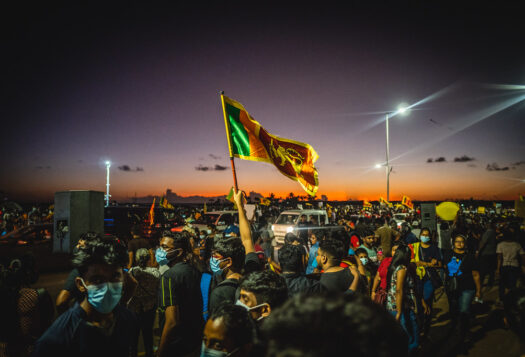
From April 12 to April 20, 2021, civic life in all major cities of Pakistan halted due to violent protests led by Tehreek-e-Labbaik Pakistan (TLP) – a right-wing religious political party known for its street demonstrations. Founded in 2015, TLP subscribes to the Barelvi sect – one of the largest sectarian groups in Pakistan – and, hence, holds credence amongst a significant section of the population despite its nascent political presence. In the past, the party has mostly succeeded in meeting its demands through mass anti-government demonstrations, but the current wave of protests, instigated by French President Emmanuel Macron’s support of Prophet Muhammad’s caricatures, resulted in violent clashes with police followed by an official ban of TLP. Instead of holding down the fort in the face of brutal attacks against the police, the government partially accepted TLP’s demand by presenting a resolution in the Pakistani National Assembly on the expulsion of the French envoy.
From meeting unreasonable demands of extremists to utilizing brute force, Pakistani governments in the past have largely failed to address the root cause of extremism – state-backed Islamic nationalism. To effectively counter recurrent religious militancy, state institutions need to gradually secularize the country. Considering secularization is a long-term process and the current government of Pakistan supports Pakistan’s deep-rooted Islamic identity, in the short-term the current government can discard its oscillating policy towards militants and focus on dialogue and diplomacy with religious stakeholders as the first step towards national peace and security in line with its much-touted National Action Plan. Without a focused, elaborate plan to take on extremism, Pakistan is bound to face extremist threats for years to come.
Traditional Approaches to Militancy
In 1953, a mere six years after the creation of Pakistan, right-wing political parties banded together and started a movement against the minority Ahymadiya religious community in Pakistan, demanding to officially declare Ahmadis as non-Muslim as their belief on the finality of the Prophet Muhammad was controversial. As violent riots began in Lahore, the federal government chose to crush demonstrations with force. Considering there weren’t any tangible policies implemented to address the ideological and social dimensions of the issue, this problem resurfaced in 1974 when protests and mob violence swept across Punjab. This time, the use of state force proved unsuccessful. Eventually, the government accepted the unreasonable demands of the protestors, declaring the Ahymadiya community as a non-Muslim minority on Sept 7, 1974. A wrong, and dangerous precedent was, hence, set.
The government has vacillated between two extreme options: caving into militant demands or wide-scale military operations against religious extremists. Neither has nor will work.
In May 1994, another extremist movement, titled Tehreek-e-Nafaz-e-Shariat-Mohammadi (TNSM), started in the Malakand Division in current-day Khyber Pakhtunkhwa with the mission to enforce Sharia-based laws in the region. Sufi Muhammad, a radical Pakistani cleric trained by the Pakistan military to fight against the Soviets in Afghanistan, started mobilizing people to enforce an Islamic system in Pakistan similar to the one established in Afghanistan by the Taliban. The government’s approach to the problem lacked any continuity – they jumped from accepting his demands to arresting his supporters. While Sufi Muhammad was in jail, TNSM joined hardline Tehrik-e-Taliban Pakistan (TTP) – a Pakistan-based terrorist organization – to restart the movement in 2007. After several rounds of failed negotiations between the central government and the extremist TNSM-TTP alliance, the government organized a military operation against the dissenters to bring peace to the region.
Similarly, in the case of Lal Mosque, a mosque and madrasah in Islamabad allegedly involved in training militants and suicide bombers for the Taliban, the government initially followed the policy of appeasement and even apologized to the mosque authorities for a police attempt to raid the mosque on its alleged involvement in the 2005 London bombing. However, by 2007, as mosque authorities started challenging the writ of the government by harassing and abducting domestic and foreign citizens for not following their stricter religious code, the government had to intervene. After failing to reach a negotiated settlement for the release of abductees, an anti-terrorism operation was launched, costing several lives. The violent episode inside the premises of the mosque, considered sacred by many Pakistanis, was a serious blow to the image of then-President General Pervez Musharraf. These three cases illustrate that the government has vacillated between two extreme options: caving into militant demands or wide-scale military operations against religious extremists. Neither has nor will work.
Continuation of Flawed Responses
Stuck between the responsibility to maintain law and order and the widespread popularity of TLP, the current Pakistani government is repeating past governments’ mistakes. When the TLP emerged in 2015 to demand the release of the murderer of the Governor of Punjab Salman Taseer, who was killed for voicing the need to revise blasphemy laws of Pakistan, the ruling Pakistan People’s Party (PPP) government of the time could not come up with a strategy to desensitize the topic of blasphemy. In 2017, when TLP protestors blocked the Faizabad interchange in Islamabad to protest a change of wording in a clause on the finality of the Prophet Muhammad in the Election Act 2017, the Pakistani army intervened, brokered a deal between the government and the protestors, and bribed the extremists to end the protest. Not only did the army intervention undermine government authority but also the deal was in favor of protestors and led to the resignation of Law Minister Zahid Hamid.

Recently, when TLP demanded to expel the French ambassador to Pakistan and ban French products, the government initially tried to win time by assuring the TLP leadership that they would meet their demand through parliamentary means by April 20. Instead of negotiating a practical solution with the TLP, the government delayed any discussion of this issue. As the deadline neared, the TLP’s new chief Saad Hussain Rizvi issued a video message calling the party workers to prepare for protests. Without any consideration of possible repercussions, the government arrested Saad Rizvi on April 12.
The least the current government can do is to take measures against extremists in line with the NAP, starting by regulating seminaries and preventing the re-emergence of banned organizations such as the TLP.
This seemingly impromptu shift in the government’s strategy resulted in large-scale demonstrations across the country followed by roadblocks in major urban centers and highways, destruction of property, and violent clashes with the police. Interestingly, as the government announced to ban the TLP and explicitly used force against the protestors, Prime Minister Imran Khan endorsed the TLP’s anti-French narrative on Twitter shortly after. TLP’s arrested leadership was released and the government established a parliamentary committee to discuss the possibility of severing diplomatic ties with France. This policy upturn, however, is unsurprising considering Imran Khan’s sympathy for the Taliban, which makes him unfit to counter TLP.
Conclusion
Evidently, and unfortunately, Pakistani governments have refused to learn from its past. Firstly, there can be no military solution to disbanding the TLP as the party boasts a wide following across the country. The Pakistan army, being the architect of the country’s Islamic-nationalist narrative, might be reluctant to use force against the group on the sensitive issue of blasphemy. Secondly, succumbing to militant pressure is no solution either for that can tarnish Pakistan’s international image and sustain militant power. Banning the TLP is also fruitless, as Pakistan has previously allowed members of banned religious militant groups to run for elections. The problem of religious extremism in Pakistan is entrenched in the religio-political national identity of the country. A redefinition of identity would require both time and courage. The least the current government can do is to take measures against extremists in line with the NAP, starting by regulating seminaries and preventing the re-emergence of banned organizations such as the TLP.
Both traditional approaches to militancy – appeasement and military force – weaken the power of the government. The policy of appeasement puts state authority into question and encourages other religious groups to engage in violent riots and demonstrations to have their demands met. Military operations, on the other hand, increase sympathy amongst the masses for the cause of militancy. The solution lies in a moderate approach, which then lies in between the two extremes – utilizing diplomatic means to reach a practical solution to the perennial problem. Such diplomatic effort requires consistency and continuity and involvement of all major religious stakeholders, while establishing that no religious group is above law, and all must adhere to principles of democracy and justice.
***
Click here to read this article in Urdu.
Image 1: Kanwar Rehman Khan via Wikimedia Commons
Image 2: Imran Khan Offical via Facebook


